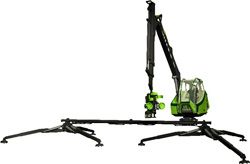Tree harvesting – with giant steps through the forest

Currently, when trees are cut down on an industrial scale (what the expert calls “tree harvesting”), heavy wheeled or tracked vehicles are employed which were often designed for field work or building sites, and weigh up to 55 tons when loaded.
As a consequence, large areas of forest floor are destroyed, and its regeneration can last many decades. Instead of improving these systems, the mechanical engineer Christian Knobloch has invented a new movement concept from scratch by applying constructional-geometrical optimisation methods.
His “striding harvester”, weighing only 7.5 tons, combines a number of valuable advantages. Like a horse's hoof, it presses down on the soil selectively, and as a result, the soil can recover much faster than it could after being heavily disturbed by conventional forestry machines. In addition, the patented concept allows for stepping over ditches and other obstacles of up to 4.6 metres wide. Marshy ground and inclines as steep as 36% are no problem for the futuristic strider.
How does this form of movement actually work? “This new striding movement has no prototype in nature”, explains Christian Knobloch. “The payload moves on a kind of bridge with three cantilevered feet on each end that are able to adapt to the ground surface. After each step, a new direction can be chosen, whereby the bridge moves forwards or backwards in the stepping direction. The payload carried by the mechanism consists of a cabin, traction technology, and a telescopic crane. The payload always bears down on one of the two 'legs' or bases, which enables the unloaded base to pivot around it in a space-saving way.”
The new kind of movement offers many benefits. Apart from its unequalled “step” of 8 metres, the “striding harvester” can reach trees at a distance of 10 metres within a working area of 480 square metres. The splayed out cantilevered feet provide a large platform that enables the crane to lift heavy weights in spite of the relatively light weight of the machine. All the critical areas related to the striding mechanism were analysed in detail by the creative industrial designer in his diploma thesis, which was supervised by Dr. Günter Kranke (Centre for Industrial Design, TU Dresden), and evaluated according to statics criteria.
As a by-product of the work, which deals primarily with tree harvesting, Knobloch, in collaboration with Prof. Jörn Erler, developed an idea about a simple, inexpensive and soil-friendly way of transporting felled trees. This means of transport would ideally complement the stepping machine concept, and would make the purchase of a “striding harvester” even more attractive to forest owners. Christian Knobloch discloses that potential industrial partners are already queuing up at his doorstep. The concept of constructing a “friendly, industrious, agile, and robust machine”, which is much more attuned to work in the forest than any chunky tracked vehicle, has obviously worked out.
At the third “Industrial Design” symposium, to take place in the historic buildings of the Deutsche Werkstätten Hellerau on the 17th and 18th of April 2009, Christian Knobloch is to be presented with the “Rudi Högner Advancement Award for Industrial Design” for his diploma thesis.
Information for journalists:
Christian Knobloch, Tel. +49 160 – 99612936,
E-Mail: christian_knobloch@gmx.net
Dr. Günter Kranke, Tel. +49 351 463-35755,
E-Mail: guenter.kranke@tu-dresden.de
Information about the symposium:
3rd Symposium Technisches Design Dresden 2009 (17-18 April 2009)
Organiser: Freunde und Förderer des Technischen Designs an der TU
Dresden e.V.
Location: “Deutsche Werkstätten Hellerau”, Moritzburger
Weg 67, 01109 Dresden
Media Contact
All latest news from the category: Machine Engineering
Machine engineering is one of Germany’s key industries. The importance of this segment has led to the creation of new university degree programs in fields such as production and logistics, process engineering, vehicle/automotive engineering, production engineering and aerospace engineering among others.
innovations-report offers informative reports and articles covering technologies such as automation, motion, power train, energy, conveyor, plastics, lightweight construction, logistics/warehousing, measurement systems, machine tools and control engineering.
Newest articles

First-of-its-kind study uses remote sensing to monitor plastic debris in rivers and lakes
Remote sensing creates a cost-effective solution to monitoring plastic pollution. A first-of-its-kind study from researchers at the University of Minnesota Twin Cities shows how remote sensing can help monitor and…

Laser-based artificial neuron mimics nerve cell functions at lightning speed
With a processing speed a billion times faster than nature, chip-based laser neuron could help advance AI tasks such as pattern recognition and sequence prediction. Researchers have developed a laser-based…

Optimising the processing of plastic waste
Just one look in the yellow bin reveals a colourful jumble of different types of plastic. However, the purer and more uniform plastic waste is, the easier it is to…



